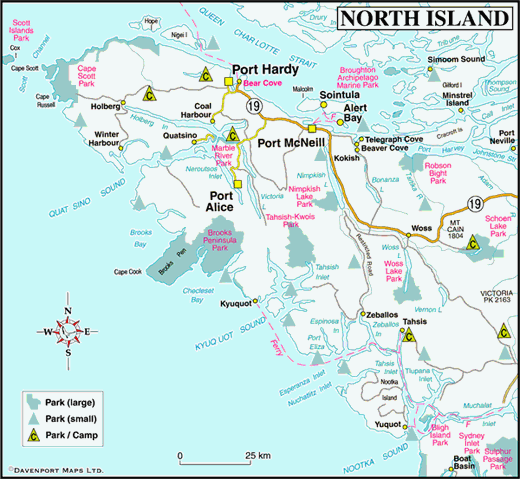Premier Listings for Port Eliza Inlet
Port Eliza is a remote wilderness inlet just inside and north of the entrance to Esperanza Inlet, on the pristine west coast of Vancouver Island. Port Eliza Inlet, which is close to Ferrer Point and some of the best fishing in the Nootka Sound area, is renowned for its spectacular sportfishing for salmon, halibut, ling cod and rockfish.
This region of the Pacific Ocean teems with a variety of other marine life such as seals, sea otters, whales and sealions. Black-tail deer and black bears are frequently observed on land, a variety of seabirds thrive in the remote and rugged shoreline, and the skies are home to the majestic bald eagle.
This stretch of the wild west coast offers everything that anglers, kayakers, divers, and outdoor adventurers are looking for, including isolation and tranquility. Port Eliza, Esperanza and Nuchatlitz Inlets are dotted with islands and reefs, numerous rock outcrops, and expansive kelp beds that create a pristine and unspoiled marine setting.
This region is rich in native culture and history, being the traditional territory of the Nuu-chah-nulth First Nation, who inhabited these lands for thousands of years before the arrival of the Spanish in 1774, and Captain James Cook in 1778.
Location: Port Eliza Inlet is located on the north central west coast of Vancouver Island in British Columbia, between Nootka Sound and Kyuquot Sound. The inlet is accessed by boat or water taxi from the communities of Gold River, Tahsis and Tahsis, all of which are accessed by road on the Highway 28 that runs from Campbell River on the east coast of Vancouver Island. Port Eliza Inlet can also be reached by floatplane from Vancouver, Victoria and Seattle.
Fishing in the area is excellent for deep sea fishing and saltwater fly fishing. Large spring or chinook salmon migrate down the west coast of Vancouver Island on their way to their spawning grounds in the rivers of Vancouver Island and the coastal mainland of BC, by way of the Juan de Fuca Strait at the southern tip of the island. Salmon fishing begins in May and runs through to September, with the peak Springs run in mid-August – Pin Rock and Black Rock off the entrance to Esperanza Inlet are popular spots for Springs. Depending on the year’s run, the Department of Fisheries and Oceans closes Esperanza Inlet to fishing south of Little Zeballos River by the middle of August. The shelving bottom around Catala Island provides good bottom fishing, with halibut tipping the scales at between 40 and 200 pounds.
Catala Island Marine Provincial Park incorporates Catala Island and Twin Islands in Esperanza Inlet, protecting numerous reefs, islands, islets and marine ecosystems. Catala Island itself is forested with mature trees, twisted and stunted by the strong winds blowing off the Pacific Ocean. A lake and bog area are also found on the island. The 850-hectare wilderness park, which incorporates 254 hectares of upland and 596 hectares of foreshore park, is an area with important significance to the island’s First Nations people. An Indian Reserve is situated at the extreme eastern tip of Catala Island, with access prohibited to visitors.
The park has no facilities, but sea kayaking and wilderness camping in the many informal campsites attracts visitors to the island to explore the reefs, lakes, bogs and the rugged shoreline. Rustic trails lead to the lake and bog in the centre of the island. The tall trees on the island are twisted by the fierce winter winds and form a ragged backdrop to the island’s smooth and sandy beaches. The eastern tip of the island is a First Nations reserve, where visitors should not trespass. Boats anchored in the Rolling Roadstead anchorage of Catala Island will be subjected to the constant and steady swell from the Pacific, with little respite. Nearby Queen Cove off Esperanza Inlet provides a sheltered overnight anchorage. Nearby Queen Cove on Vancouver Island is the nearest all-weather anchorage from which boaters may access Catala Island.
Nuchatlitz Provincial Park is located on the western tip of Nootka Island, between Nuchatlitz and Esperanza inlets. A great diversity of flora and fauna is protected within an extensive range of terrestrial, intertidal and marine environments. Nuchatlitz is an excellent place to study intertidal life, as many tide pools can be found throughout the maze of islets and reefs that make up the park.
The 2,135-hectare park (803 hectares upland and 1,332 hectares foreshore) also protects vital habitat for British Columbia’s recovering Sea Otter population. The remote islands are becoming a popular kayaking destination, offering both exposed coast and protected waters for paddling, quiet coves and a multitude of beaches. A wealth of opportunities for outdoor enthusiasts exists, including boating, sport fishing, camping and wildlife viewing within the park and its surrounding area. There are sheltered camping areas on some of the islands, but no facilities are provided within the park. Access to the park is by boat from Zeballos, 18 km to the northeast.
Esperanza Inlet and Nuchatlitz Inlet along with the finger inlets that branch off from them (Port Eliza, Espinosa Inlet, and Zeballos Inlet) were gouged out by glaciers during the last ice age, and are extremely remote and sparsely populated. This isolation is enhanced by the stunning scenery, attracting anglers, kayakers, divers, campers and hikers to the wilderness area.
Premier Business Directory in Port Eliza Inlet, Vancouver Island – Small Business BC
No results.



